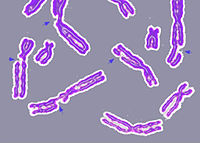
Intersections between transcription-coupled repair and alkylation damage reversal.
Sign Up to like & getrecommendations! Published in 2019 at "DNA repair"
DOI: 10.1016/j.dnarep.2019.102663
Abstract: The response to DNA damage intersects with many other physiological processes in the cell, such as DNA replication, chromatin remodeling, and the cell cycle. Certain damaging lesions, such as UV-induced pyrimidine dimers, also strongly block… read more here.
Keywords: damage reversal; alkylation damage; damage; transcription coupled ... See more keywords

Modulation of Cytotoxicity by Transcription-Coupled Nucleotide Excision Repair Is Independent of the Requirement for Bioactivation of Acylfulvene.
Sign Up to like & getrecommendations! Published in 2017 at "Chemical research in toxicology"
DOI: 10.1021/acs.chemrestox.6b00240
Abstract: Bioactivation as well as DNA repair affects the susceptibility of cancer cells to the action of DNA-alkylating chemotherapeutic drugs. However, information is limited with regard to the relative contributions of these processes to the biological… read more here.
Keywords: dna; bioactivation; transcription coupled; cytotoxicity ... See more keywords

Cell-Free Transcription-Coupled CRISPR/Cas12a Assay for Prototyping Cyanobacterial Promoters.
Sign Up to like & getrecommendations! Published in 2021 at "ACS synthetic biology"
DOI: 10.1021/acssynbio.1c00148
Abstract: Cyanobacteria are promising microbial hosts for the production of diverse biofuels and biochemicals. However, compared to other model microbial hosts such as Escherichia coli and yeast, it takes a long time to genetically modify cyanobacteria.… read more here.
Keywords: crispr cas12a; transcription; free transcription; cell free ... See more keywords

Transcription-coupled repair and mismatch repair contribute towards preserving genome integrity at mononucleotide repeat tracts
Sign Up to like & getrecommendations! Published in 2020 at "Nature Communications"
DOI: 10.1038/s41467-020-15901-w
Abstract: The mechanisms that underpin how insertions or deletions (indels) become fixed in DNA have primarily been ascribed to replication-related and/or double-strand break (DSB)-related processes. Here, we introduce a method to evaluate indels, orientating them relative… read more here.
Keywords: repeat tracts; mononucleotide repeat; strand; transcription coupled ... See more keywords

Structural basis of human transcription-DNA repair coupling.
Sign Up to like & getrecommendations! Published in 2021 at "Nature"
DOI: 10.1038/s41586-021-03906-4
Abstract: Transcription-coupled DNA repair removes bulky DNA lesions from the genome1,2 and protects cells against ultraviolet (UV) irradiation3. Transcription-coupled DNA repair begins when RNA polymerase II (Pol II) stalls at a DNA lesion and recruits the Cockayne… read more here.
Keywords: transcription; dna repair; coupled dna; transcription coupled ... See more keywords

A disease-associated XPA allele interferes with TFIIH binding and primarily affects transcription-coupled nucleotide excision repair
Sign Up to like & getrecommendations! Published in 2023 at "Proceedings of the National Academy of Sciences of the United States of America"
DOI: 10.1073/pnas.2208860120
Abstract: Significance Nucleotide excision DNA repair (NER) removes a large variety of genomic lesions. NER can be initiated through two distinct pathways: global genome repair (GG-NER) and transcription-coupled repair (TC-NER). Both pathways subsequently funnel into a… read more here.
Keywords: xpa; transcription; nucleotide excision; transcription coupled ... See more keywords